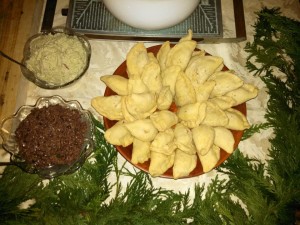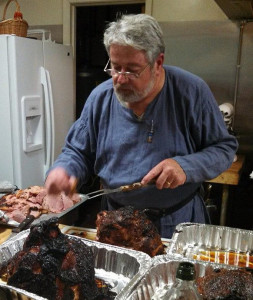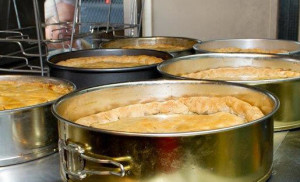I really had no intention of cooking another feast, at least not so soon. But, I was convinced by Event Stewards and soon-to-be Lyondemere Reeves Patraic and Fausta that I could do it my way, with their full support and cooperation, so I agreed and set to work.
The Event Announcement described the celebration:
As winter closes in on Caid, Yule is a time to gather together as a family to reflect on the year past, and to rejoice in the upcoming renewal of a new year. The Baronies of Lyondemere and Gyldenholt gather together at this time every year as a family in joy and merriment. Delectable foods, activities and fun will celebrate this past year, and renew our spirits as we prepare to welcome 2014. Please join us in warmth and fellowship.
I was anxious to try a casual, but elegant, ‘served-buffet’ feast. I wanted the hall to reflect the bounties of the Barony, a wide array of seasonal, period dishes set on beautifully dressed tables. Much of the food preparation could be done in advance and the kitchen staff could spend the meal time serving (exercising portion control), and being a part of the evening festivities, rather than spending Yule locked away in a busy kitchen.
I originally planned for three tables, plus one more dessert table, to be located in different areas of the hall. We actually were able to utilize two long tables for the main meal dishes, and one smaller dessert table. After the head table was served, guests were invited to choose either table to start, and return as often as they liked once everyone was served.
<><><>
We had a nice variety on each table, as follows:
Table One: Moorish Gourdes in Pottage; fresh bread; olive tapenade; Moretum; Sallet of beets, currants and greens; Norse pies; baked ham; mustards; Meatballs in Eggplant Sauce
Table Two: pork sausage; Apples in Red Wine; Andalusian chicken sausage; Spinach Dumplings; Salat with chickpeas; German Onion Pie; leek & apple pie; Compost
Dessert Table: Seedy Cakes; Daryols; Apple-Pear Tarte; pumpkin pie, gingerbread, shortbread
<><><>
Notes on Table One dishes:
I don’t think that anything can be as warm and welcoming on a winter’s evening than soup! I chose my favorite squash pottage recipe, which we kept warm in generously-sized soup tureens. In medieval France, squash (courges) were cooked in bouillon and mashed. I have replaced the culitivated gourds of the period, cucurbita, with butternut squash, a suitable modern substitution. Pottages were made throughout medieval Europe of many different vegetables, and I chose to make mine in the Moorish style, adapted from the following:
55. MOORISH GOURDS [ Ruperto de Nola, 1525, Libro de Cozina]
CALABAZAS A LA MORISCA
Scrape the gourds very well until they are very clean and white, and then make wide slices and cut them like round fingers; and take onion and cut it in the same way as the gourd, and to each gourd put two onions; and when they are cut, cast them in good mutton broth that is boiling well; and when they are cooked, cast upon them goat milk or sheep milk, and if there is none, cast in almond milk; and cook the milk well with the gourds; and when the milk is cooked, turn them well with your haravillo and cast upon them good grated cheese and fine spices; and also cumin, and caraway, and a pair of eggs for each dish; and turn it all together and prepare dishes; and cast sugar and cinnamon upon them.
I cooked the squash and mashed them, and added them to a vegetable stock seasoned with cumin and caraway, some grated Parmesan cheese, and a little cinnamon and sugar. I added a bit of almond milk, as well.
The soup was served with fresh bread, olive tapenade and Moretum (a combination of cheese, garlic and herbs, pounded together into a paste). Both spreads are common to Ancient Rome.
From Robert May’s The Accomplished Cook (published in 1660):
A grand sallet of beets, currants and greens.
Take the youngest and smallest leaves of spinage, the smalest also of sorrel, well washed currans, and red beets round the centre being finely carved, oyl and vinegar, and the dish garnished with lemon and beets.
193. Norse pies. [Le Viandier de Taillevent, 14th c. France]
Take cooked meat chopped very small, pine nut paste, currants, harvest cheese crumbled very small, a bit of sugar and a little salt.
Chicken thighs are often used in this dish, but I used cooked turkey (one of the first New World foods to really catch on in 16th century Europe). I was able to get a very good price following Thanksgiving, and the turkey meat remained very moist and flavor-able.
The hams were baked with an apricot-mustard glaze. In all the frenzy of the kitchen, we forgot the ovens were on! And THIS is one of the reasons I am so fond of baking hams — they looked dreadfully overcooked, but were DELICIOUS! The lovely, crisp layer of fat served well to keep the juices in and the meat nice and moist. I served two of my homemade mustards with the ham. Yum!
78. Meatballs in Eggplant Sauce. [Bagdad Book of Cookery, as in Pleyn Delit]
Take eggplant, and boil lightly in water and salt, then take out and dry for an hour. Fry this in fresh sesame oil until cooked; peel, put into a dish or a large cup, and beat well with a ladle, until it becomes like kabis. Add a little salt and dry coriander. Take some Persian milk, mix in garlic, pour over the eggplant, and mix together well. Tale red meat, mince fine, make into small cabobs, and melting fresh tail, throw the meat into it, stirring until browned. Then cover with water, and stew until the water has evaporated and only the oils remain. Pour on top of this the eggplant, sprinkle with fine ground cumin and cinnamon, and serve.
I admit, this is one recipe I have overlooked in my copy of Pleyn Delit, for years! It wasn’t until my garden was overrun with ripe eggplant that I tried it, and am I glad I did! This recipe is a real keeper, and my household loves the sauce so much we serve it over Makerouns (Noodles and Cheese). I roast the eggplant when it is ripe, and freeze it for later use.
<><><>
Notes on Table Two dishes:
Domhnall’s Famous Pork Sausages, spiced with just the right amount of our own house Poudre Forte spice blend, are always a hit! This time, I chose to pair them with Apples Cooked in Red Wine, another of my favorite do-ahead recipes. To please the non-pork eaters attending the feast, we added a chicken sausage to the menu:
Dish of Chicken or Whatever Meat You Please. [The Andalusian Cookbook/A Collection of Medieval and Renaissance Cookbooks, Vol. II, David Freidman]
If it is tender, take the flesh of the breast of the hen or partridge or the flesh of the thighs and grind it up very vigorously, and remove the tendons and grind with the meat almonds, walnuts, and pinenuts until completely mixed, throw in pepper, caraway, cinnamon, lavender, in the required quantity, a little honey and eggs, beat all together until it becomes one substance, then make with this what looks like an ‘usba’ made of lamb innards and put it in a lamb skin or sheep skin and put it on a heated skewer and cook slowly over a fire of hot coals until it is browned, then remove it and eat it, if you wish with murri and if you wish with mustard, if God so wills.
This was delicious! We made this dish with chicken thigh meat, the nuts, herbs and spices mentioned, and added in the honey and eggs. We used pork casings, rather than lamb, which worked well for us. I worried that additional fat would be needed, but the sausages were moist and quite flavorful.
119 If You Would Make Boiled Dumplings. [Das Kuchbuch der Sabina Welserin, 16th C Germany] Then take chard, as much as you like, some sage, marjoram and rosemary, chop it together, also put grated cheese into it and beat eggs therein until you think that it is right. Take also cinnamon, cloves, pepper and raisins and put them into the dumpling batter. Let the dumplings cook, as one cooks a hard-boiled egg, then they are ready.
Quite a few of Sabina Welserin’s recipes suggest substituting spinach for chard, or one herb for another, indicating her desire to use what is on hand and available. I found it easier to use frozen chopped spinach, as I was cooking for 100 guests. I also used sage and oregano, and currants instead of raisins.
One of my favorite medieval recipes, as recorded by Master Chiquart Amiczo, the chief cook to a 15th century French Duke, is referred to as Syseros (Du fait de cuisine, 76). It is really quite versatile, and intended to be so. As written, it translates to a Chickpea Puree, much like today’s popular hummus — but with almond oil instead of sesame paste. It is delicately spiced with vinegar and cinnamon (to be added on approval of a doctor), sage and parsley. It can serve as the base of a soup, or be added to one to boost the flavor. Finally, the seasoned chickpeas can be left intact, cooled, and tossed with fresh salad greens. This was my choice for the Yule menu, as it was an excellent way to boost the protein for vegetarians and satisfy modern palates with a 15th century French recipe.
There had to be pies! I have so many good recipes for period (savory) pies and tarts that it was difficult to choose. I settled on two of my favorites. The Leek & Apple Pie is a very simple recipe with lots of flavor — leeks and apples sauteed, piled in a crust and topped with cheese. The German Onion Pie satisfies with the beloved combination of bacon and cooked onion. I think the flavors of both are best when the pies are served at room temperature, so these were two perfect choices for a feast. Filled ahead and refrigerated uncooked, they were baked, early, on site and allowed to cool until service began.
I love using preserved foods for feasts! Nothing makes me feel quite more medieval (other than cooking with wood fire) that preserving seasonal foods for future use, something I admit to doing, anyway, with my home garden. But, simply using frozen or commercially canned out-of-season foods, for a feast, seems too much like cheating for me. The following recipe is one of my favorites, as the ingredients can be modified to reflect available fruits and vegetables. It also remains very pretty, and jars can be used as part of the table setting.
Compost. [Curye on Inglish, 14th c England]
Take rote of persel, of pasternak, of rafens, scape hem and waische hem clene. Take rapes & caboches, ypared and icorue. Take an erthen panne with clene water & set it on the fire; cast alle thise therinne. Whan they buth boiled cast therto peeres, & parboile hem wel. Take alle thise thynges vp & lat it kele on a faire cloth. Do therto salt; whan it
is colde, do hit in a vessel; take vyneger & powdour & safroun & do therto, & lat alle thise thynges lye therin al nyyt, other al day. Take wyne greke & hony, clarified togider; take lumbarde mustard & raisons coraunce, al hoole, & grynde powdour of canel, powdour douce & aneys hole, & fenell seed. Take alle thise thynges & cast togyder in a pot of
erthe, & take therof whan thou wilt & serue forth.
“Take parsley root, carrots, radishes, scrape them clean. Take white radishes & cabbages,pared and cored. Take an earthen pan with clean water & set it on the fire; and put all these in. When they’re boiled, add pears and parboil well. Take all these things out and let cool on a clean cloth. Add salt. When cooled, place in a container; add vinegar, powder and saffron, and let sit overnight. Take Greek wine & honey, clarified together; take ‘lumbarde’ mustard and whole currants, and cinnamon, powdour douce & whole anise seed & fennel seed. Take all these things and place together in an earthen pot, and take from it when you need to, and serve.”
<><><>
Notes on the Dessert Table offerings:
If I was to do this again, I would not have a separate dessert table. We took home too many leftovers from this table! Perhaps we medieval cooks have convinced the populace that sweets should be eaten along side of savory, after all? Or, perhaps the other food was so delicious that no one had room for dessert? Whatever the case, the desserts looked lovely, and added to the season’s bounty!
<><><>
It has become somewhat of a tradition to sing the Wassail! at Lyondemere Yule each year. This year, we tried something different, our take on a “flash mob” performance. It was great fun, and well received (and participated) by all!
Hear the song here: Wassail wassail all over the town
<><><>
Thank you to Domhnall, Etiennette, Maren, Peregrine, Elva and Grace, for helping me make and serve a delicious and memorable feast!
“S ann nas fheàrr a bhith fìor ceart ‘sa linn.”






